Fly
There are more than 240,000 different species!
Advertisement
Fly Scientific Classification
Read our Complete Guide to Classification of Animals.
Fly Conservation Status
Fly Facts
- Favorite Food
- Nectar
- Common Name
- Fly
- Number Of Species
- 240000
- Location
- Worldwide
- Slogan
- There are more than 240,000 different species!
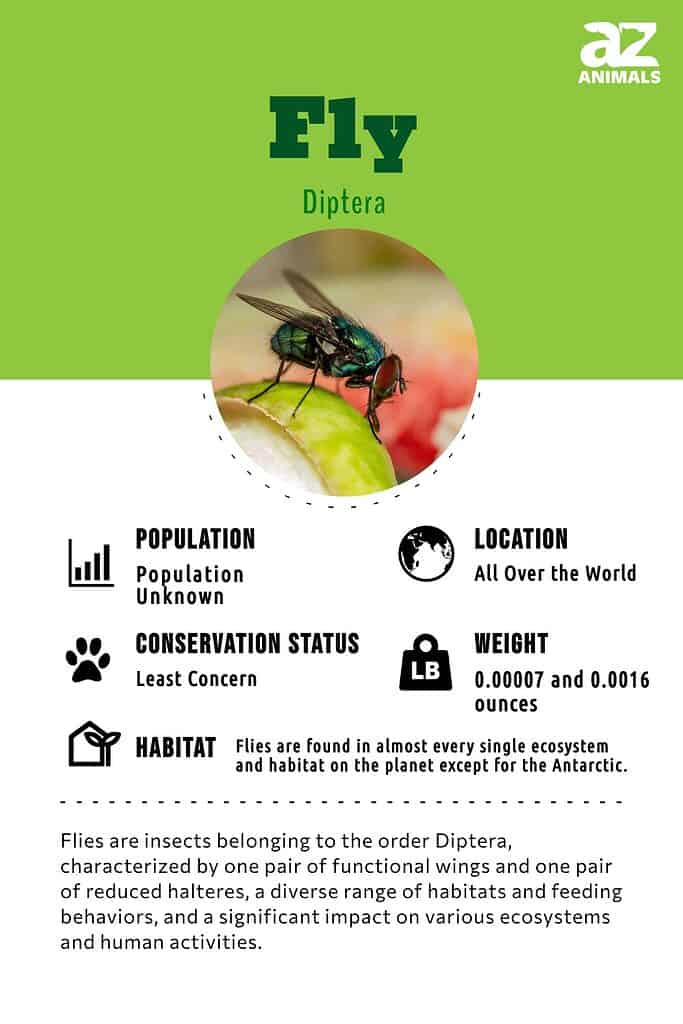
The fly is one of the most common and diverse groups of animals on the planet.
Although they so often share an antagonistic relationship with humans as an annoyance or a potential carrier of diseases, these insects also serve many important ecological roles.
They are the second most common pollinators, behind only bees. They help to keep the environment free of decomposing animal flesh. And as a common subject of genetic research, they also help to advance the frontiers of human knowledge.
5 Incredible Fly Facts!
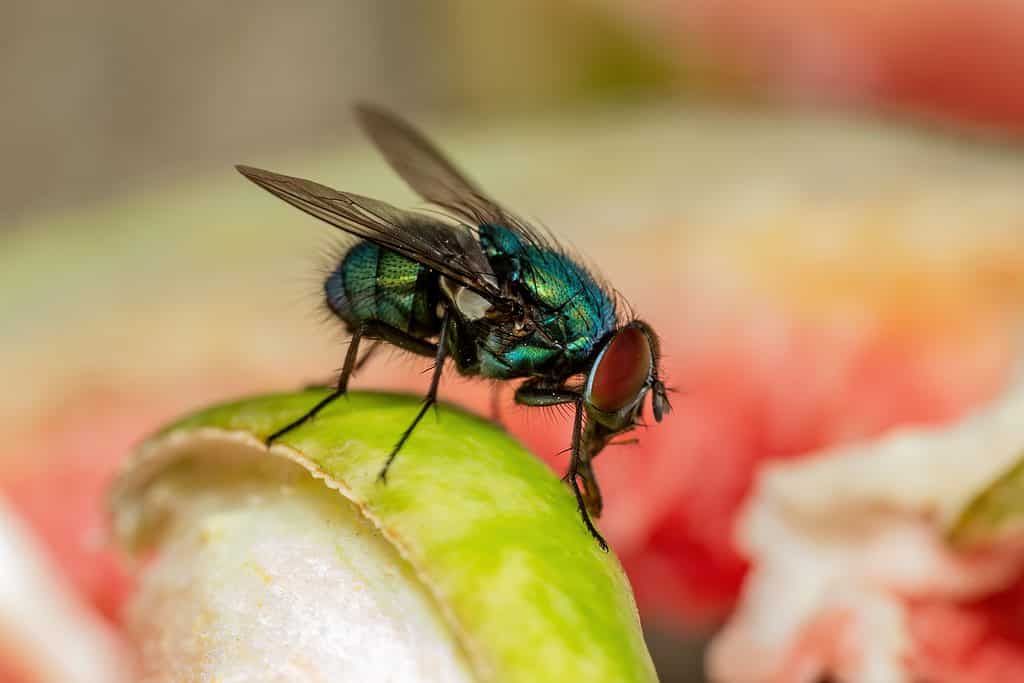
The insect’s lifespan lasts only a few weeks long. However, in this short time, it is very reproductively active. A single female can lay 500 eggs every three to four days.
©nechaevkon/Shutterstock.com
Here are a few fly facts:
- The evolutionary history of these insects dates back some 240 million years in the fossil record.
- These insects rub their legs together in order to keep them clean. The bristles on the legs are important sensory organs that can taste the food they land on.
- The maggots, which feed on decomposing tissue, have historically been used by humans to clean wounds.
- These insects undergo four different life stages. The first stage, the egg, only lasts matter of eight to 12 hours. After hatching, the insect enters a prolonged larval stage in which it goes through a few different molting periods over the course of several days or weeks. The third stage, the pupa, is an intermediate form between larva and adult. It lasts an average of five days. The final adult phase mostly serves the purpose of reproduction.
- The insect’s lifespan lasts only a few weeks long. However, in this short time, it is very reproductively active. A single female can lay 500 eggs every three to four days.
Species, Types, and Scientific Names
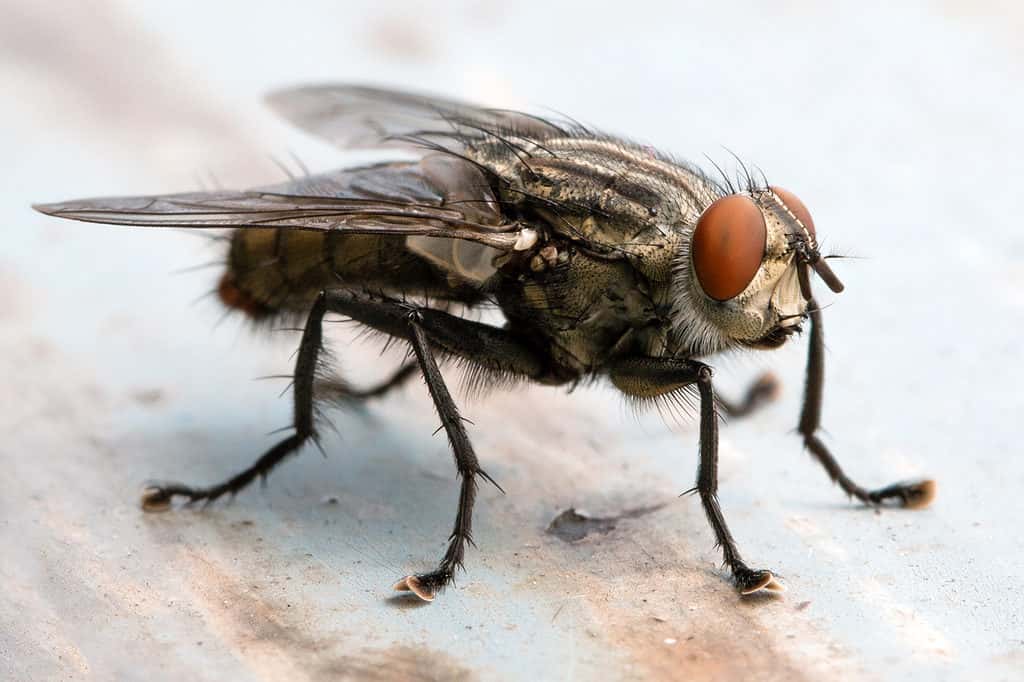
The most common fly species Americans are likely to find in their houses in winter are cluster flies, fruit flies, or house flies.
©Abel Tumik/Shutterstock.com
The scientific name for the fly order is Diptera (meaning two-winged in Greek). This order contains an astonishing amount of variety. More than 125,000 species have so far been described, but there could be up to a million species in total.
House, horse and blow flies are obvious examples, but what many people may not know is that even mosquitoes, midges, and gnats are members of the same order as well.
Here is a list of the major groups:
- House and dung flies – Muscoidea
- Blow and flesh flies – Oestroidea
- Marsh flies – Acalyptratae
- Louse flies – Hippoboscoidea
- Hoverflies - Syrphoidea
- Flat-footed flies – Phoroidea
- Dance flies – Empidoidea
- Robber and bee flies – Asiloidea
- Horse and snipe flies – Tabanomorpha
- Stink flies – Xylophagomorpha
- Soldier flies – Stratiomyomorpha
- Crane flies – Tipuloidea
- Drain and sand flies – Psychodomorpha
- Mosquitoes – Culicomorpha
- Gnats – Bibionomorpha
- Midges – Blephariceromorpha
Here are additional fly species:
- Psychodidae
- Botfly
- Tsetse fly
- Black fly
- Crane fly
- Black soldier fly
- Hoverflies
- Ceratopogonidae
- Nematocera
- Brachycera
- Sciaridae
- Ephydridae
- Cheese fly
- Picture-winged flies
- Tachinid flies
- Cecidomyiidae
- Long-legged flies
- Opesia
- Stalk-eyed fly
- Chloropidae
- Sciomyzidae
- Piophilidae
- Myopa
- Conopidae
- Braulidae
- Sphaeroceridae
- Sepsidae
- Vermileonidae
- Heleomyzidae
- Oestroidea
- Athericidae
- Platypezidae
- Nerius
- Pilaria
- Xylophagidae
- Coelopidae
- Rhinophoridae
- Cryptochetidae
- Milichiidae
- Chionea
- Neriidae
- Corethrellidae
- Erioptera
- Idiocera
Evolution and Origins
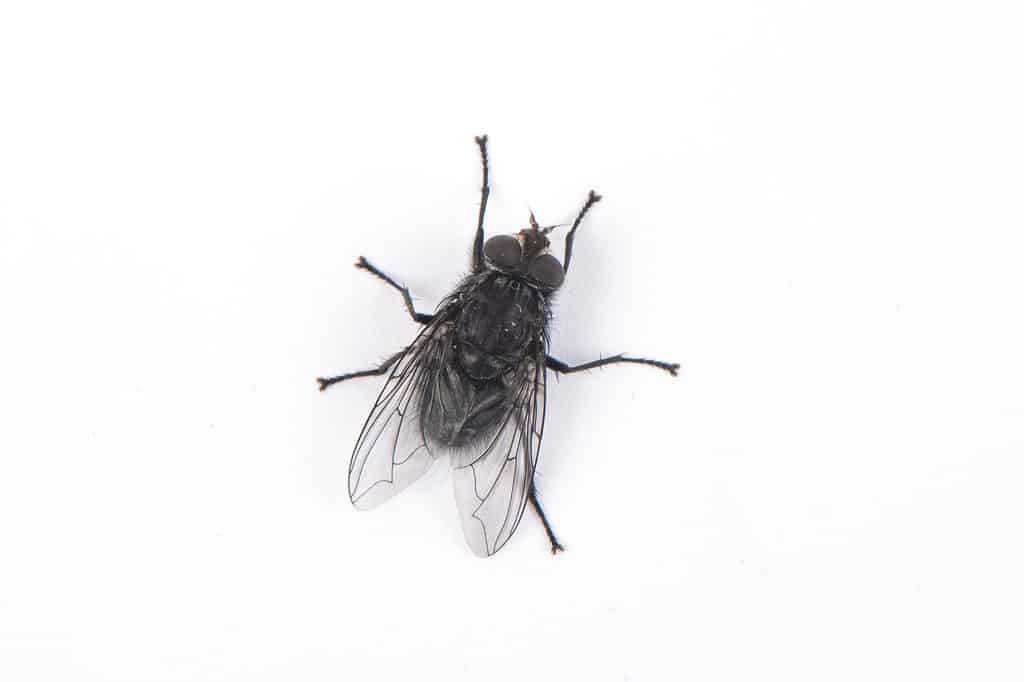
Black flies are infamous for their bites that cause itching, swelling, and inflammation.
©iStock.com/zhikun sun
The origins of insects date back to the Carboniferous period, about 350 million years ago. Flies, specifically, belong to the order Diptera, which is derived from Greek, meaning “two-winged.” Dipterans have one pair of functional wings and one pair of reduced halteres, which serve as balance organs during flight.
The evolution of Diptera is linked to the development of flowering plants, as flies played a crucial role in pollination. Over time, many species of flies have adapted to different environments and food sources, resulting in a diverse group of insects that includes many species of mosquitoes, houseflies, fruit flies, and others.
Insects, including Dipterans, underwent significant evolution and diversification during the Mesozoic era, resulting in the wide variety of species we see today. Diptera has adapted to many habitats and feeding behaviors, including some species that are predators, parasites, and decomposers, while others are important pollinators.
One important factor in Dipteran evolution is the development of mouthparts. Many flies have evolved specialized mouthparts to feed on nectar, blood, or other specific food sources. This has allowed them to occupy different ecological niches and adapt to a variety of environments.
Appearance
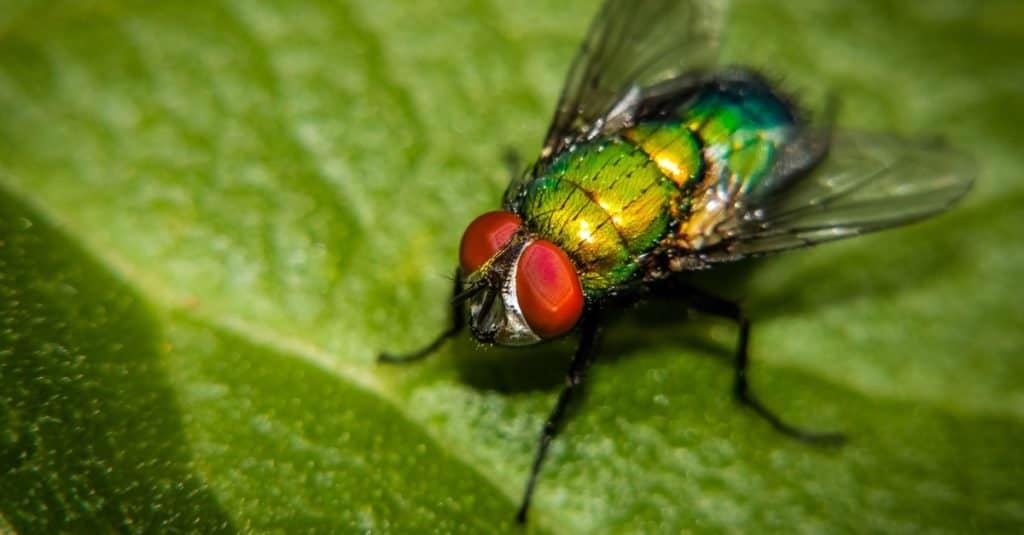
The order of Diptera comes in so many shapes and sizes that it is difficult to say anything precise about it, but the one trait that unites all of them together is the dual-wing structure.
©Jeroen Mikkers/Shutterstock.com
The order of Diptera comes in so many shapes and sizes that it is difficult to say anything precise about it, but the one trait that unites all of them together is the dual-wing structure. The first pair of wings are used for flight, while the second reduced pair is used primarily for balance and maneuverability.
Other important features include two large compound eyes, claws or pads that enable them to stick on smooth surfaces, and complex mouthparts designed for some combination of sucking, lapping, and piercing. Most species in this order measure less than an inch long.
The largest species is the South American fly, Gauromydas heros, which can measure up to 3 inches.
Habitat
Flies can be found in a wide variety of habitats, from tropical rainforests to arid deserts. Some species are adapted to specific environments, while others are more generalist and can be found in many different types of habitats.
These insects are found in almost every single ecosystem and habitat on the planet except for the Antarctic. They seem to pose the greatest danger to human health in certain warm and tropical regions.
Some common habitats for flies include:
- Forests: Many species of flies, including some of the larger species, can be found in forests, where they feed on nectar, fruits, and other organic matter.
- Grasslands: Grasslands provide habitats for many species of flies, including some of the most common types such as houseflies and horseflies. They feed on a variety of plant and animal matter, including nectar, feces, and carrion.
- Deserts: Some species of flies have adapted to the harsh conditions of deserts, where they feed on a variety of resources, including nectar, plants, and small insects.
- Agricultural areas: Agricultural areas provide habitats for many species of flies, including those that feed on crops, livestock, and other agricultural products. Some species of flies, such as fruit flies, are specially adapted to feed on ripe fruit.
- Urban areas: Many species of flies, including houseflies and blowflies, have adapted to urban environments, where they feed on human food waste and other organic matter.
- Aquatic habitats: Some species of flies, such as mosquitoes and midges, have adapted to live in aquatic habitats, where they feed on algae, aquatic plants, and other organic matter.
The specific habitat requirements for different species of flies vary, and many species can adapt to new habitats as they become available. However, all flies require some type of organic matter, such as food or breeding sites, to survive and reproduce.
Diet
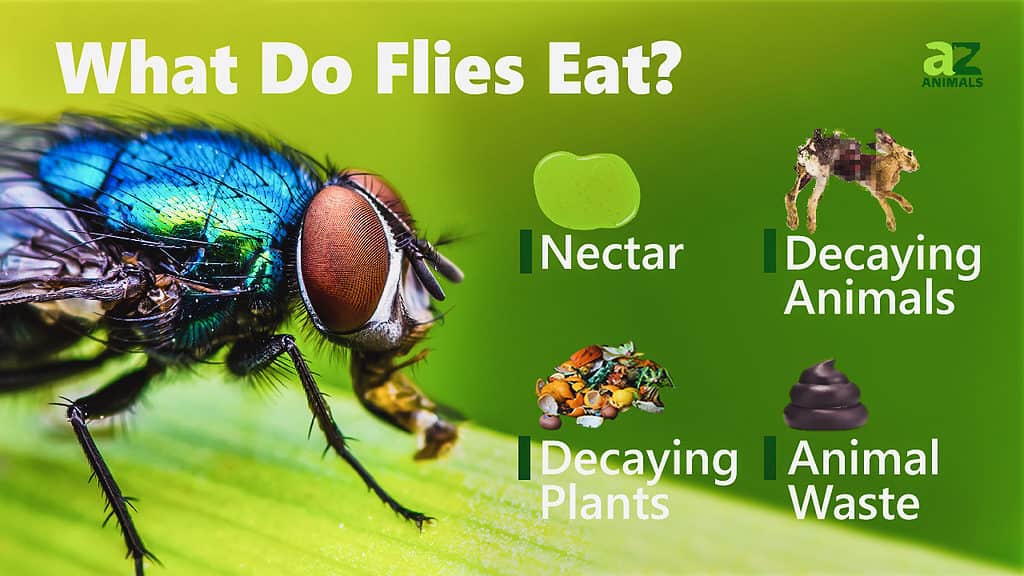
These insects have adapted all kinds of feeding strategies. They can be herbivorous, carnivorous, scavengers, decomposers, and even parasites. Most species have evolved to consume decaying organic matter from fruits, vegetables, meat, and even feces.
Mosquitoes, tsetse flies, and many other types survive by feeding on the blood of vertebrate animals, while other species feed directly on the flesh.
Prevention
The best way to prevent these insects in the first place is to eliminate all sources of decaying food matter (including both human and pet food) around the home. Proper food storage and regular cleaning are a necessity for maintaining a fly-free environment.
If you want to get rid of the insects that have already entered your home, then you should invest in proper traps, electric insect zappers, and sprays. They also seem to have an aversion to strong herbs such as mint, lavender, and bay leaf.
Keep your doors and windows closed as often as possible and try to eliminate or cover up any holes where they can get in.
View all 91 animals that start with FFly FAQs (Frequently Asked Questions)
Are Flies herbivores, carnivores, or omnivores?
Flies are Omnivores, meaning they eat both plants and other animals.
What Kingdom do Flies belong to?
Flies belong to the Kingdom Animalia.
What class do Flies belong to?
Flies belong to the class Insecta.
What phylum to Flies belong to?
Flies belong to the phylum Arthropoda.
What order do Flies belong to?
Flies belong to the order Diptera.
What type of covering do Flies have?
Flies are covered in hair.
Where do Flies live?
Flies are found worldwide.
In what type of habitat do Flies live?
Flies live close to organic waste.
What do flies eat?
Flies can eat almost any kind of organic matter, particularly if it’s already begun decaying. But some fly species are specialized for consuming blood or animal flesh directly.
What would happen if flies went extinct?
If flies went extinct it would cause problems across the world with decaying organic matter. While bacteria and other insects will also consume decaying matter, flies do it much more quickly.
Thank you for reading! Have some feedback for us? Contact the AZ Animals editorial team.
Sources
- Britannica / Accessed February 19, 2021
- Raid / Accessed February 19, 2021


















